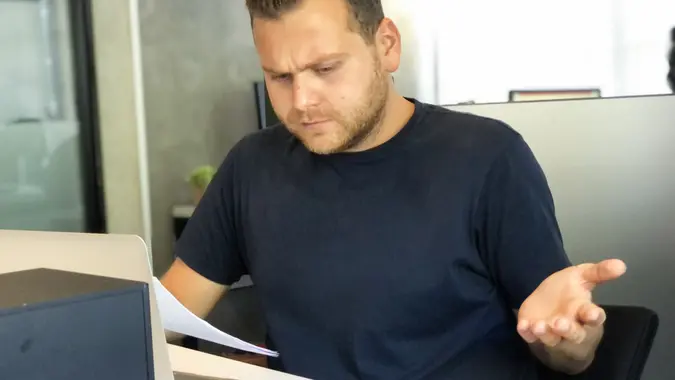Are Dave Ramsey’s 7 Baby Steps for Building Wealth Outdated? George Kamel Says No

Commitment to Our Readers
GOBankingRates' editorial team is committed to bringing you unbiased reviews and information. We use data-driven methodologies to evaluate financial products and services - our reviews and ratings are not influenced by advertisers. You can read more about our editorial guidelines and our products and services review methodology.

20 Years
Helping You Live Richer

Reviewed
by Experts

Trusted by
Millions of Readers
Dave Ramsey is famous for his 7 Baby Steps, which focus on building a solid financial foundation, getting rid of debt and growing wealth. This plan isn’t without controversy, though, as some people view Ramsey’s recommendations as outdated or disagree with how Ramsey prioritizes certain money moves.
However, Ramsey personality George Kamel attributes the 7 Baby Steps to helping him become a millionaire, and believes they’re still useful in 2025. In a recent YouTube video, he addressed some common criticisms, and explained the benefits of following each step.
Step 1: Have a $1,000 Starter Emergency Fund
While $1,000 might seem like too little for emergency savings, a Federal Reserve report showed 37% of American adults didn’t even have enough cash for a $400 unexpected expense in 2024. So, it’s still a better safety net than many others have.
Kamel also explained that saving this small initial amount lets you move on to tackling your debt sooner. It’s an early success that helps motivate you, and you’ll build up a bigger cushion later.
Step 2: Eliminate Consumer Debt
Eliminating your consumer debt will free you from the related interest charges, monthly payments and dent in your net worth. This step includes tackling things like credit cards, auto loans and student loans, but excludes your home’s mortgage for now.
“The reason you can hold off on paying your mortgage loan is because real estate is an asset that will reliably grow in value over time,” said Kamel. “Plus, it’s a mountain to pay off that giant loan.”
Ramsey’s approach also involves the debt snowball method, which can seem counterintuitive since it ignores interest rates and focuses only on the debt size. However, Kamel explained that the key is momentum that keeps you moving with your financial plan.
Step 3: Fully Fill Your Emergency Fund
Being free of consumer debt should free your budget so you can return to filling up your emergency fund with the suggested three to six months of your usual expenses.
Kamel explained that this step works since the larger financial cushion helps you avoid taking on future debt and being in crisis mode when unexpected expenses do arise. Plus, if you use a high-yield savings account, you can begin growing this cash at a modest rate.
Step 4: Save 15% for Retirement
According to Fidelity’s Q2 2025 retirement analysis, American employees contributed 9.5% of their pay to 401(k) accounts. Ramsey’s plan involves contributing 15% of your pre-tax income to a tax-advantaged retirement account, and there’s a good reason behind this target rate.
“We’ve just found that if you invest too much, you don’t have any extra margin to throw at saving for college or paying off the mortgage or sinking funds for vacations and car repairs and upgrades,” explained Kamel. “And if you don’t invest enough, well, you’re not going to have enough in retirement to actually live off of and retire with dignity.”
Kamel also used the Ramsey retirement calculator to demonstrate that investing $1,000 monthly at a 10% return can help you become a millionaire even if you start in your early 40s.
Step 5: Save for Your Children’s College
While some people believe it’s an either-or situation, Kamel explained that you should work on this optional step simultaneously with the fourth. That way, you can help out your children without sacrificing your financial security in retirement.
Kamel didn’t mention a specific amount for your children’s college fund, so you’ll want to decide what works for you. He did, however, recommend using a 529 plan due to the account’s federal tax-deferred growth, high contribution limits and the ability to roll over $35,000 of the unused money to your child’s Roth IRA.
Step 6: Pay Your Mortgage Off Early
Especially if you have a low mortgage rate or want to prioritize investing, you might be skeptical of Ramsey’s advice to pay off your mortgage early. Kamel said it’s worth it, though, as you’ll be able to use your mortgage payment money for other things and have less financial risk overall.
He also highlighted the financial freedom that comes with being completely debt-free. For example, it might allow you to work less or pursue opportunities you couldn’t afford before. You might find this flexibility more valuable than any low mortgage rate you’ve locked in.
Step 7: Build Wealth and Give
As you stay debt-free and continue to invest, you’ll build more wealth that allows you to not only live the life you want to live or pursue early retirement, but also make an impact on others.
Kamel added, “Being able to give generously and give to those you love, give to causes you care about or just give spontaneously to those in need — that’s what makes the [7 Baby Steps] worth it.”
 Written by
Written by  Edited by
Edited by 

























